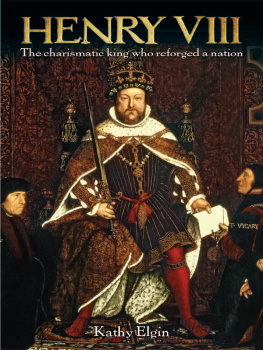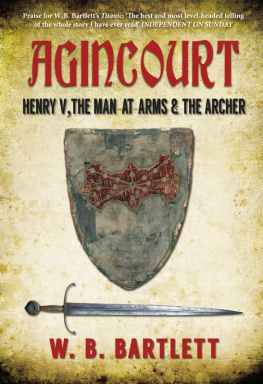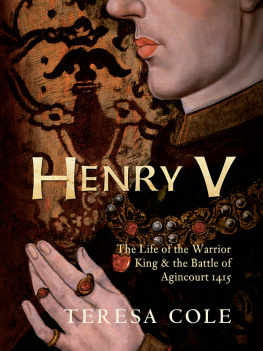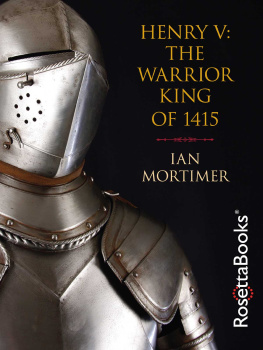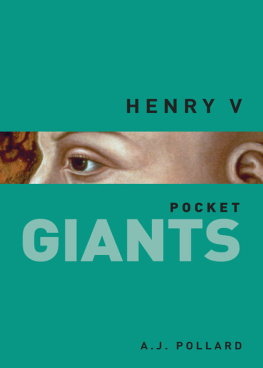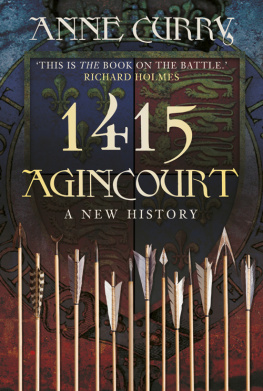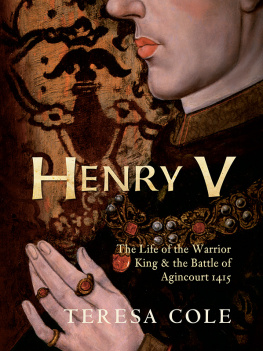
HENRY V
A HISTORY OF HIS MOST IMPORTANT PLACES AND EVENTS
HENRY V
A HISTORY OF HIS MOST IMPORTANT PLACES AND EVENTS
DEBORAH FISHER

First published in Great Britain in 2022 by
PEN AND SWORD HISTORY
An imprint of
Pen & Sword Books Ltd
Yorkshire - Philadelphia
Copyright Deborah Fisher, 2022
ISBN 978 1 39907 046 1
ePUB ISBN 978 1 39907 047 8
MOBI ISBN 978 1 39907 047 8
The right of Deborah Fisher to be identified as Author of this work has been asserted by him in accordance with the Copyright, Designs and Patents Act 1988.
A CIP catalogue record for this book is available from the British Library.
All rights reserved. No part of this book may be reproduced or transmitted in any form or by any means, electronic or mechanical including photocopying, recording or by any information storage and retrieval system, without permission from the Publisher in writing.
Pen & Sword Books Limited incorporates the imprints of Atlas, Archaeology, Aviation, Discovery, Family History, Fiction, History, Maritime, Military, Military Classics, Politics, Select, Transport, True Crime, Air World, Frontline Publishing, Leo Cooper, Remember When, Seaforth Publishing, The Praetorian Press, Wharncliffe Local History, Wharncliffe Transport, Wharncliffe True Crime and White Owl.
For a complete list of Pen & Sword titles please contact
PEN & SWORD BOOKS LIMITED
47 Church Street, Barnsley, South Yorkshire, S70 2AS, England
E-mail: enquiries@pen-and-sword.co.uk
Website: www.pen-and-sword.co.uk
Or
PEN AND SWORD BOOKS
1950 Lawrence Rd, Havertown, PA 19083, USA
E-mail: Uspen-and-sword@casematepublishers.com
Website: www.penandswordbooks.com
Contents
Acknowledgements
It would not have been possible for me to write this book without the careful research into the period already done by distinguished historians, particularly Anne Curry and Juliet Barker. I can claim no personal credit for their work and I have drawn on it extensively.
I would like to thank:
As ever, Phil Carradice, for help and advice whenever I needed it.
Bob Cowie, the Syon Abbey Society, and my friend Lorraine Mepham, for archaeological input.
The MonmouthpediA project, led by John Cummings. Throughout my research, Wikipedia has been used as it is intended to be used not as a direct reference, but as a source of citations and useful summaries.
The late Rhys Jones, a reliable and always enthusiastic friend and collaborator.
Introduction
It is 600 years since the death of King Henry V, one of Englands best-known kings. Many books have been written about his life, a majority of which concentrate entirely on his victory at the Battle of Agincourt in 1415. Shakespeare, in his cycle of history plays, depicted Henry in a flattering but largely realistic manner, showing the wayward young man as well as the inspirational warrior. The plays were based on history as Shakespeare knew it, but the story they told was some way from the truth. They have misled many people into believing that Agincourt was Henry Vs main achievement, and that the circumstances of that achievement were very different from what they actually were.
Shakespeare did not invent everything he wrote from scratch, but he was born over a century after Henry died, and had to rely on earlier writers whose idea of history was very different from our own. Not only did medieval chroniclers tend to be prejudiced in favour of their home countries thus English and French writers give contradictory versions of Henrys actions but they were writing history as a story, and did not hesitate to embellish that story with details that they felt would make it more interesting to their readers. Few of them had witnessed at first hand the events about which they wrote. Fortunately, documentary records exist for the period that have enabled modern historians to reconstruct the facts and events of Henrys career in a more impartial and more realistic way. It is the everyday records, ranging from the proceedings of parliament to parish registers, shopping lists and invoices, that enable us to place him in certain places at certain times. Archaeological investigation also continues to play an important role in any attempt to visualise the past.
This book, in keeping with its place in the Following in the Footsteps series, is a kind of travelogue, concentrating on places that were important in Henrys life, many of which can still be visited by those interested in getting a better feel for the man and understanding how his character was shaped by his environment. Perhaps it is wrong to suggest that it is literally possible to follow in Henrys footsteps. Records of his reign and activities are plentiful but cannot always give an exact picture of where he was at a given time. The roads he took, particularly during his military campaigns in Wales and France, may no longer be passable; they may have been abandoned or built over, or perhaps were never known to anyone outside Henrys immediate circle. Nevertheless, those who at least make the attempt to pass the same way as Henry will discover that he was far more than a one-battle-wonder.
Henry V was not born to rule. Despite being the great-grandson of a king, he was born in a small country town, far from London, and spent much of his youth on military campaigns in Ireland, Wales and the Marches. After his father usurped the throne in 1400, he helped resist Owain Glyndwrs rebellion and became battle-hardened as a teenager when he received a near-fatal wound at Shrewsbury in 1403. Despite falling out with his father and at one time being expelled from the government, he quickly reinvented himself as a model king, and set his eyes firmly on the prospect of the crown of France. Thereafter, much of his nine-year reign was spent on military campaigns beyond the British Isles. The Battle of Agincourt, at the height of his powers, was one of the most spectacular victories ever won by an English army, but it is not the whole story.
The book takes its reader on a journey from the rural areas around Monmouth, where Henry was born, to the magnificent royal court of his fathers cousin and enemy, King Richard II. It takes us into the wilds of Wales and across the sea to the even wilder Irish landscape, where the teenage boy won his spurs and was knighted by King Richard. We follow his short-lived career as a student at Oxford. We see the prince reunited with his father in England, and we travel with him into battle at Shrewsbury against his fathers former supporters. We see him capture Harlech Castle from the rebel followers of a rival Prince of Wales. We witness his coronation at Westminster Abbey, and visit his private retreat at Kenilworth. As king, we see him seize Harfleur and then take the long road towards Calais, culminating in the battle for which he will always be best remembered. Thereafter, we follow his continued campaigning in France as he struggles to get a firm hold on the French crown, his marriage to Catherine of Valois at Troyes, and his eventual, tragically premature, death at the Chteau de Vincennes.
What emerges is a picture of a man much influenced by his environment, both the physical environment and the company of those he encountered in the course of his travels. All personalities are, at least in part, the product of experience, but this is particularly true of King Henry V. Those who know his story seldom fail to be both fascinated and moved by it, and this makes him an ideal subject for the study that follows.
Next page





